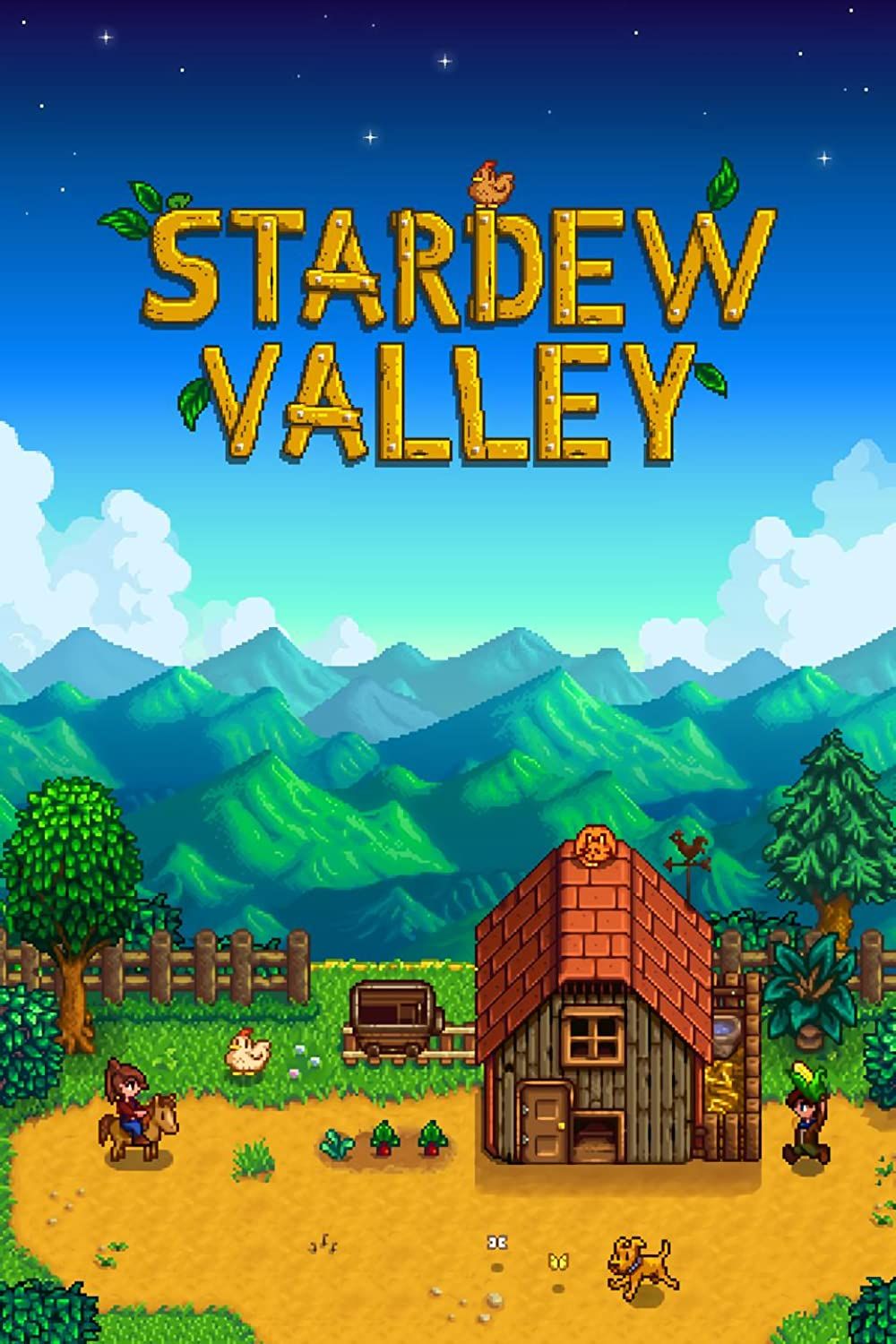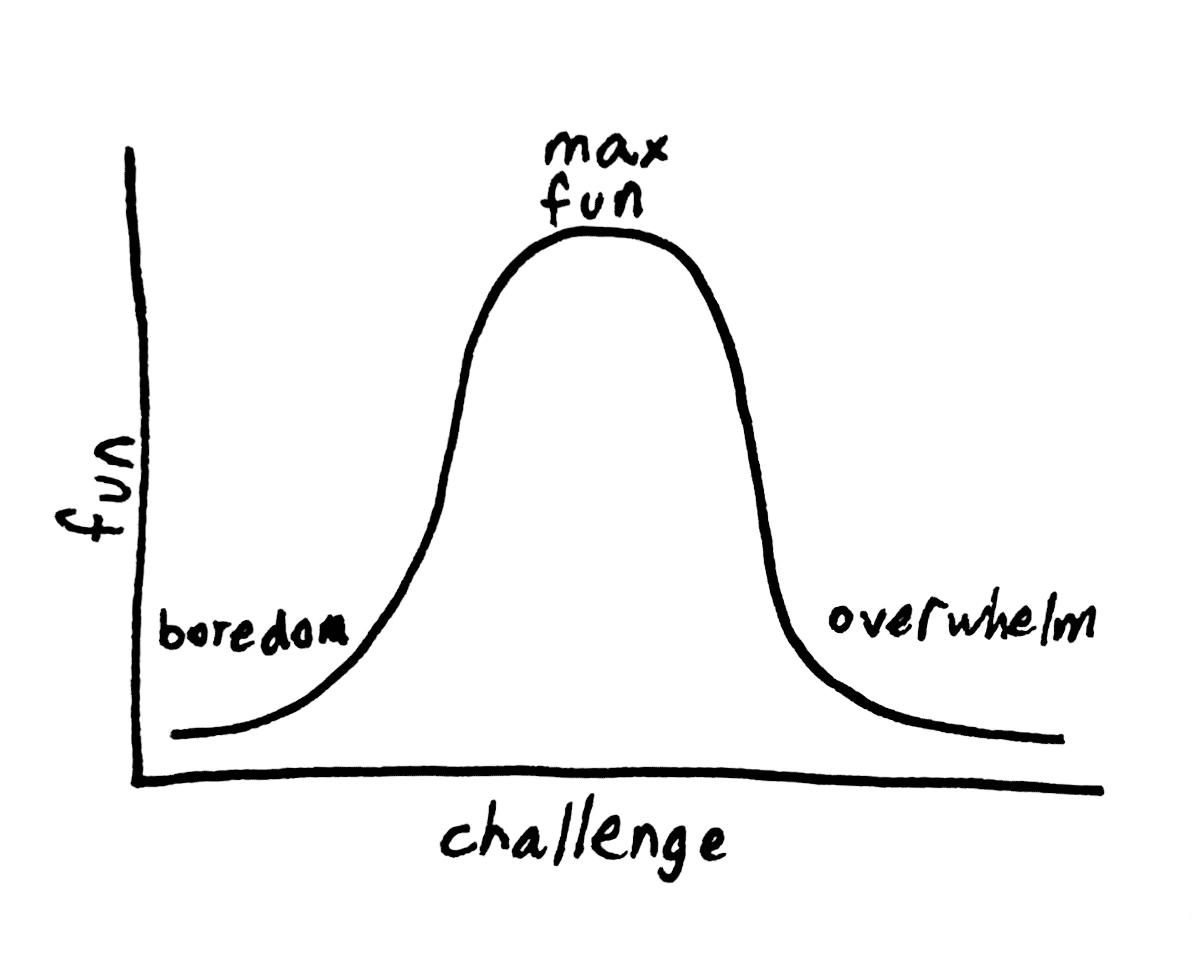Max Fun Maslow
Last updated 2025-10-19
Definition
Max Fun Maslow is a game where the goal is to get people’s needs met in ways that are maximally fun. That is, not only is it fun to reach the end result where people’s needs are successfully met, but the process of getting there is itself fun (and the process of making the process fun is also fun).
Game labor

Why do people voluntarily put significant time and effort into game labor but struggle to apply the same time and effort in real life labor? Why are farming tasks in Stardew Valley or management tasks in Factorio so compelling but similar kinds of labor IRL is not? Why do we yearn for the mines of Minecraft, but not actual mines?
The answer I propose here is that games have three characteristics that make labor fun instead of, well, laborious. These characteristics are:
- Low stakes environment (safe to fail)
- Goldilocks challenge level (neither boring nor overwhelming)
- Intermittent rewards (consistent surprise)
Low stakes environment
Games are typically low stakes. The phrase “it’s just a game” communicates that the activity described is not actually consequential in real life.
Low stakes environments provide opportunities to engage in activities that would otherwise be too risky. Thus, players can perform laborious tasks without feeling threatened or stressed out. Players know that their fundamental safety is unaffected by whatever happens in the game, so it’s much easier to focus on the enjoyable aspects of the tasks without worrying about anything else.
With real life labor, the stakes are much higher. Your income, your social status, your physical safety. Any or all of these things might be at stake, which can make seemingly ordinary tasks into very stressful experiences. But games typically do not have this problem.
Goldilocks challenge level

The Goldilocks zone of challenges sits between boredom and overwhelm. This zone is maximally engaging. This is where people enter into a state of flow. Games are specifically designed to keep the challenge level in this Goldilocks zone.
Intermittent rewards
Games usually have some sort of intermittent reward structure. That is, there is a steady stream of unpredictable payoffs. When people describe games as “addictive”, they’re talking about the effectiveness of the intermittent reward structure.
When the completion of a task reliably produces a predictable reward, then the task gets boring pretty quick, even if the reward is big. But if it only produces a reward sometimes, then it feels much more compelling, even if the reward itself is relatively small. The unpredictability makes it exciting. This is why gambling can be so addictive.
The Game of Max Fun Maslow
Max Fun
We can think of Max Fun as a game where the goal is to make the game as fun as possible by cultivating and maintaining the three characteristics described above.
It’s a bit like Calvinball in that the rules of the game are themselves variables in the game that the players can modify.
It’s also a bit like comedy improv in that whatever situation unfolds is always accepted as a valid game state (the “yes” part of “yes and”), and each advancement in the game builds on the current situation as its premise (the “and” part of “yes and”).
However, the game of Max Fun itself does not have any object-level goals, only the process-level goal of maximizing fun in the pursuit of whatever object-level goal is chosen.
Maslow’s hierarchy of needs
People have needs. Maslow’s hierarchy is one of many models of human needs, and it is perhaps the most widely known model. The details of the model are not actually that important for our purposes here. The important thing is that it is a recognizable model of common human needs.
Max Fun + Maslow’s hierarchy = Max Fun Maslow
Because the game of Max Fun requires players to generate their own object-level goals, and Maslow’s hierarchy of needs is basically a structured arrangement of common object-level goals, the combination of these two concepts yields a game that is coherent enough and compelling enough to warrant being categorized as an actual game rather than just a “game” in a metaphorical sense.
This game can be played as a single-player game, multiplayer game, collective-player game, or all of the above simultaneously.
Starting with low stakes needs
It might be counterintuitive, but it’s best to start with low stakes needs in order to maintain a safe-to-fail environment. If you have urgent survival needs, attending to low stakes needs can seem like the exact opposite of what you should do. It can seem like a distraction to spend time and energy on non-essential needs like socializing when there are more urgent problems to address. But in the long run, you will gain more momentum when you start with moderate challenges that are not overwhelming, and then gradually increasing the stakes as your skill level increases.
Gradually increasing the stakes
As your skill level increases, challenges that were previously overwhelming become easier to handle. This is when you raise the stakes. You must be careful not to overwhelm yourself or other players, but raising the stakes helps people get more of their needs met and have more fun.
Generating serendipity
Serendipity occurs when you make unexpected fortunate discoveries. By definition, serendipity is both helpful and unpredictable. The unpredictability is important as it relates to intermittent rewards.
In the context of Max Fun Maslow, serendipity is what allows players to discover new ways to get people’s needs met, and because this discovery process is unpredictable, it can provide a steady stream of intermittent rewards that keep the game fun.
Serendipity is not something that can be generated on command. However, through the aggregation of a high number of potential occurrences, we can reliably generate a smaller but still high number of actual occurrences. It’s a numbers game.
This brings us to the activities of the game.
Game activities
These are the three main activities of the game:
- Generative quests
- Unblocking
- Fun calibration
Generative quests
One type of game activity is a generative quest. A generative quest is any attempt to break out of your normal behavior patterns with the intention of making space for the possibility of discovering something that might lead to serendipitous opportunities for someone somewhere somehow. These quests can be planned or spontaneous, structured or improvised.
For example, if there’s a friend you haven’t talked to in a while and maybe there’s a possibility that a conversation with them could generate some connections that would be beneficial somehow, give ‘em a call! It can be as simple as that. Or it could be more elaborate.
An example of a structured quest might be a planned brainstorm session with a fellow participant to make a list of mutual friends and potentially fruitful introductions that could be made between them. Will this lead to new opportunities? Maybe!
The bottom line is: try stuff and see what happens! You never know what you’ll discover.
Unblocking
Another type of game activity is unblocking. Unblocking is simply removing obstacles and pathfinding towards a goal. In this case, the goal is getting needs met. It’s a bit like solving a puzzle or navigating a maze.
Fun calibration
In order to maximize fun, you must monitor your own sense of fun and calibrate your behaviors to steer towards greater levels of fun over time. If you notice that you or your fellow players feel overwhelmed or bored, you need to step back and recalibrate.
Maybe you need to ask for help. Maybe you need to break down an overwhelming task into a series of easier tasks. Maybe you need to batch a series of boring tasks into a bigger more challenging task. Maybe you need to exchange tasks with other players. Maybe you need to switch to a completely different task. Maybe you need to go on a generative quest to discover new options.
Mettā
The Pali term “mettā” is usually translated into English as “loving-kindness”. However, as with many translations, there are different ways to interpret the meaning and different ways to translate. One alternative translation that is relevant here is the feeling that remains when all of your needs have been met. That is, when you’re not in problem-solving mode, when you are not attending to unfulfilled desires, the feeling that remains is mettā.
Of course, you don’t need to wait until your needs are met before you can experience mettā. You can practice mettā at any time regardless of whether or not your needs are met. Considering the hypothetical scenario where all of your needs have been met is simply a useful prompt for understanding what mettā is.
And it is also true that when your needs are actually met, you do experience greater levels of mettā.
As you level up in the game of Max Fun Maslow, you experience more and more mettā. In fact, your experience of mettā can be a useful measure of how well you are doing in the game. Not only that, but practicing mettā makes it more fun to help others get their needs met as well.
The combination of mettā and the practice of helping people get their needs met creates a virtuous cycle that makes the game more and more fun, which makes it easier and easier for people to get their needs met, which leads to greater levels of mettā, and so on and so forth.